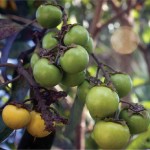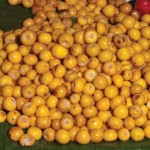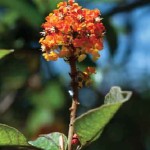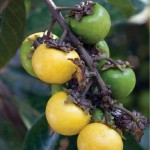The Nance Tree
Seven Macaw is the False Sun deity, featured in the Mayan myth of the Popol Vuh. His name in the K’iche’ Mayan language of Guatemala is Vukub-Cakix. The perch and favorite food of Seven Macaw is specifically identified as a nance tree in most translations of the Popol Vuh. “This is the great tree of Seven Macaw, a nance, and this is the food of Seven Macaw. In order to eat the fruit of the nance he goes up the tree every day.” (Translation by Dennis Tedlock)
Fortunately, iconographers who have looked at the trees in murals where a Principal Bird deity perches in the west wall of the San Bartolo murals have all tended to recognize that different species of trees are represented. If you look at every scene where the bird deity perches, you don’t see much nance fruit. In other words, the perch tree for the Principal Bird deity in Pre-Classic depictions is the calabash tree. It is only in the Post Classic, Highland, K’iche’ Mayan version of the Popol Vuh, that the perch is listed as a nance tree.
Like hundreds of other plants and trees, there are medicinal uses of the nance tree bark and leaves. Branches cut from the trees thrown into the water can stupefy fish; the bark can be used to tan leather. A liquor of nance is made in Mexico and in Central America, and many people speak of various medicinal uses of nance fruits or bark. The fruit is sold in large quantities in markets because it is so cheap. Sweets and desserts are made from the fruit; the juice is used for flavoring aguas gaseosas and other beverages; and the rind gives a light-brown dye that is used in Guatemala for tinting cotton textiles. Ink is sometimes made from the bitter green fruit. The bark is a favorite material for tanning skins, and an infusion of the bark is a current domestic remedy for diarrhea.
The literature states the maximum tree height variously as between 33 and 50 feet; one estimate suggests up to almost 65 feet. Surely the maximum height would vary depending on the climate, so nance trees in the savannas of Petén (near La Libertad, for example) would be shorter than nance trees outside the savanna environment.
Nance fruit is called “craboo,” “crapoo” and “wild craboo” in Belize. The common name “nance” has been utilized in such Guatemalan place names as El Nanzal (a nance grove), El Nance and Los Nances. El Nance is a town in Baja Verapaz, Guatemala. The word today is a Hispanicized version of Nahuatl (Aztec language) origin and is used throughout Central America.
The next time you are in a local market in Guatemala, or the next time you read the Popol Vuh, we hope that this introduction to the nance tree has helped you learn another bit of information about the plants used by the Maya of the past and present.
Dr. Nicholas M. Hellmuth is director of FLAAR Reports (Foundation for Latin American Anthropological Research). For a bibliography and a list of pertinent websites on the nance tree, visit www.maya-ethnobotany.org or contact Dr. Hellmuth at frontdesk@flaar.org



